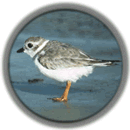|
These days, species are not becoming
 extinct for such gory or sensational reasons but, unfortunately, many are becoming extinct. Why? How many? What does it mean?
extinct for such gory or sensational reasons but, unfortunately, many are becoming extinct. Why? How many? What does it mean?
In this Eco-Logical, we reprint an excerpt of the science portion of the testimony before the US Congress (House Committee on Resources) of Joseph K. Sheldon, who is a Professor of Biology and Environmental Science at Messiah College.
~ ~ ~
Scientific Perspectives on Species Extinction and Species Protection
excerpted testimony of Joseph K. Sheldon before the House Committee on Resources, 28 Apr 2004
The branch of science that focuses on the protection of the world's species is referred to as conservation biology. In scientific circles, it is known as a "crisis discipline"—often called upon to act or advise with little or no warning, with a limited knowledge base, and frequently dealing with emergency situations. In many ways it is similar to a medical emergency room, only the patients are not humans, but rather are other creatures. The very fact that conservation biology exists is reason for concern: it is testimony to our failure to properly steward creation.
What do we know about species?
Science tells us that there are between 5 and 40 million species alive today. Approximately 1.7 million have been
 identified and cataloged. We know that millions of unidentified species exist. How many we are not sure.
identified and cataloged. We know that millions of unidentified species exist. How many we are not sure.
In the temperate areas, where the great majority of scientists work and reside, the species are relatively well known. But the species of the tropics and the deep oceans—where the majority of the world's species reside—remain largely a mystery. However, the point is not the sheer number of species; the crisis involves what is happening to known species as well as to the myriad unknown species.
(Hint: Hover your mouse over any photo to learn what it is.)
What are the primary causes of extinction?
Many factors contribute to the loss of species, including:
- the impact of introduced ("alien") species,
- pollution,
- disease, and
- excess hunting and other forms of harvesting that exploit species at a rate that exceeds their reproductive potential.
 But the single largest and expanding threat is habitat destruction caused by human actions. No species can continue to exist when its ecosystem—its very home—is destroyed. The occupied habitat of an endangered species is usually found to be reduced to a fragment of its former area and is often of marginal quality at best.
But the single largest and expanding threat is habitat destruction caused by human actions. No species can continue to exist when its ecosystem—its very home—is destroyed. The occupied habitat of an endangered species is usually found to be reduced to a fragment of its former area and is often of marginal quality at best.
Finally, it should be noted that in January 2004, a major research paper in the journal Nature identified global climate change as a major contributing factor to species decline, perhaps equal to or greater than habitat destruction.
What species are going extinct?
The best known groups of organisms are birds and mammals. Since the year 1600, a total of 83 mammals species (2.1%) and 113 birds (1.3%) are known to have become extinct. This number is expected to rise rapidly as the breeding populations of many species continue to decline. But even
 before the advent of modern technology, humanity took a heavy toll on creation. Approximately 70% of the known bird species have become extinct in the Hawaiian Islands since humans first arrived. Indeed, large-scale extinctions of Pacific island birds apparently was widespread. Recent evidence points to a loss from these islands in excess of 2,000 species following human habitation—a 20% reduction in the world's bird species.
before the advent of modern technology, humanity took a heavy toll on creation. Approximately 70% of the known bird species have become extinct in the Hawaiian Islands since humans first arrived. Indeed, large-scale extinctions of Pacific island birds apparently was widespread. Recent evidence points to a loss from these islands in excess of 2,000 species following human habitation—a 20% reduction in the world's bird species.
Evidence also links the colonization of Australia and North America with the disappearance of many species of large mammals (those over 100 pounds). More than 50 mammal species have become extinct since the arrival of humans in North America. A few thousand years ago, the western grasslands rivaled the great savannas of Africa in terms of the enormous numbers of animals. Both large grazing mammals and their predators were in abundance. Where are they today?
Determining present extinction rates and even the status of most species is difficult for all but a few well-known species groups. For example, we know that 17 of the 22 crocodile and alligator species are threatened with extinction from habitat destruction and overhunting. But what about the world's plants or its insects? Peter Raven, perhaps the world's leading specialist on tropical botany, has stated that 25% of the world's plant species are seriously threatened.
What about beetles, which represent approximately a quarter of all known species? You may be wondering why we should be concerned about beetles at all. After all, a bird or mammal must be far more important than a species of insect! Not necessarily. Each species plays a unique role in the global ecosystem.
 The loss of any species has ripple effects across the fabric of creation. In recent studies of Central and South America, more than 90% of the beetles collected were from unknown, unstudied species.
The loss of any species has ripple effects across the fabric of creation. In recent studies of Central and South America, more than 90% of the beetles collected were from unknown, unstudied species.
A single tree may have as many as 1,200 species of beetles, of which 20% are specialist feeders that occur only on that species of tree. There are approximately 50,000 species of tropical trees—each with its specialist beetle population. If the tree becomes extinct, so will the other species associated with it. And there are many other types of specialists on tropical trees besides beetles!
How are scientists able to estimate the numbers of animals going extinct?
There is a direct relationship between the size of an area and the number of species that it contains. A square yard of temperate forest habitat may have 10 species of plants, while an acre will often have hundreds. The larger the area, the more species encountered-up to a point.
Of equal importance is the range of each species. Species that are restricted to small geographic areas are much more likely to go extinct than are those with widespread distributions.
 Also, the smaller the population, the higher the probability of extinction. And therein lies a disturbing fact. It is thought that tropical species commonly have smaller populations and much more restricted distributions. Thus, destroying an acre of tropical forest will likely have a much higher extinction impact than the loss of an acre of temperate forest.
Also, the smaller the population, the higher the probability of extinction. And therein lies a disturbing fact. It is thought that tropical species commonly have smaller populations and much more restricted distributions. Thus, destroying an acre of tropical forest will likely have a much higher extinction impact than the loss of an acre of temperate forest.
Dr. Edward O. Wilson of Harvard University estimates that if 1% of the world's tropical rain forests are destroyed each year—a conservative estimate based on current rates of deforestation—then over 100 years there would be a loss of at least 20% of all species, assuming extinction rates remain constant. Based on a total of 10 million species, the current annual loss has been calculated to be 20,000 to 30,000 species.
Some studies indicate that the rate of species loss may be somewhat less, but there is no question that unless the escalating rate of habitat destruction is reversed, the extinction toll will continue to rise. And if recent evidence from studies on global climate change proves to be true, atmospheric modification may become the major threat to species in the future.
|


